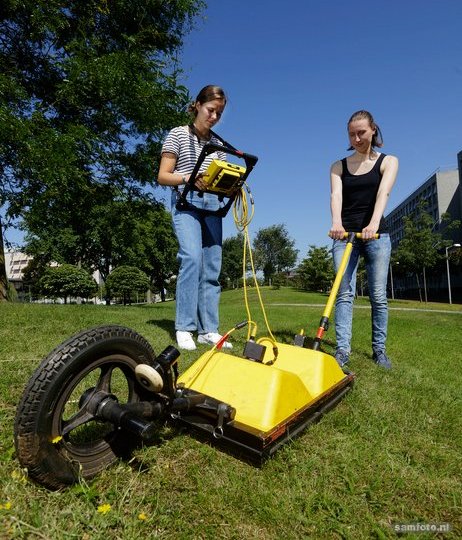Locating bodies
Searching for firearms or human remains metres underground is easier said than done.
Everyone has a general idea of how to go about finding weapons. But how do you search for human remains in hard clay soil? Students Claire Mulder and Frederikke Hansen (Applied earth sciences) know how it’s done. They used various scanning and measuring techniques, to find out if and how you can locate a body underground.
Radargrams
The research (for their Bachelor’s graduation project) was carried out at two totally different locations: the TU Delft campus and Amsterdam Medical Centre’s (AMC) forensic cemetery. They mapped these areas using a device equipped with electrical resistivity tomography (ERT) and a ground-penetrating radar (GPR).
The GPR was used to create two-dimensional images, so-called radargrams, which show reflections in the ground. Using the ERT required more effort. “For this we had to put 100 steel pins in the ground,” Mulder explains. “Using a certain pattern, you then send current into the ground and measure the resistance of the ground.”
Mulder and Hansen started by scanning the ground behind the Faculty of Civil Engineering and Geosciences. “We were looking for two barrels that had been buried there in 2018 for another graduation project,” explains Hansen. “It happened so spontaneously that the university didn’t even know about it. The students even lost the coordinates of those barrels,” laughs Hansen.
Luckily, the two quickly located the barrels and the real work in Amsterdam beckoned. Three bodies are buried in the forensic cemetery, the first and only one of its kind in Europe. There is also an empty grave. A unique location, not least because Mulder and Hansen’s research was the first of its kind to be conducted on Dutch soil. “There are very few places like this in the world,” Hansen explains. “Researchers normally use pigs, but the fat content, enzymes and chemicals present in pig carcasses are not the same as those in human remains.”
Setback
This scientific first was not without considerable challenges. Since the forensic cemetery only opened last year, little thought had been given to the type of experiments that could be carried out here. Hansen: “The two graves we were investigating were right next to a metal fence. Metal interferes with the signals from the GPR, so we couldn’t use those results.” But it was precisely this information that proved useful. “Now they know not to bury bodies near a fence in the future.”
The students also observed differences between soil where there was a body and soil where there was no body. “This is valuable information for the police. They can dig in a specific location rather than dig up entire areas,” says Mulder.
Frederikke Hansen and Claire Mulder (Civil Engineering and Geosciences) wrote individual theses on their findings. Hansen focused on the use of GPR methods for forensic research, Mulder on the use of ERT. The Bachelor’s graduation project was the result of a collaboration between TU Delft and the Netherlands Forensic Institute.
